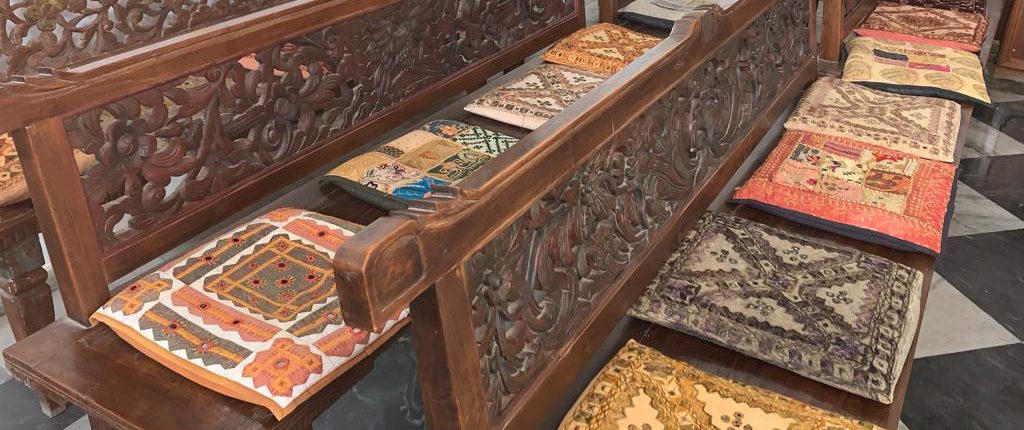Since its re-dedication in 1999, Etz Hayyim has received a number of important gifts in the form of liturgical artefacts and textiles, for example, a shofar (ram’s horn), yad pointers for Torah reading and Kiddush cups, among others.

The Treasures
The most important liturgical items are the Siphrei Torah (Torah scrolls). The first Torah scroll originates from the David ibn Zimrah Synagogue in Cairo and was gifted to Nikos Stavroulakis. Encased in its original tik (case), this Torah scroll is written on gazelle skin and bears a silver dedication. The second Torah scroll is an Eastern European one on permanent loan to the synagogue from the Westminster Memorial Scrolls Trust in London. This scroll had been brought to Prague during the Second World War along with about 1,800 scrolls. After the war, they were transferred to an abandoned synagogue at Michle near Prague. After several years of negotiation, most of these scrolls were sent to London where they were repaired and then given to synagogues in need of a Torah. This particular scroll was acquired through the assistance of Mrs Ruth Shaffer, then Director of the Memorial Scrolls Trust.
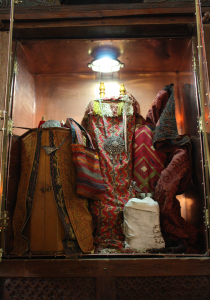
When Etz Hayyim Synagogue was reopened in 1999 as a place of prayer, it was in need of a Torah Scroll, the five Books of Moses written by hand on parchment that includes the basic laws and tenets of Judaism and is central to the synagogue service. In February 2000, Etz Hayyim received Memorial Scroll No. 1227 from the Memorial Scrolls Trust (MST) of Westminster Synagogue in London on permanent loan. The Memorial Scroll is regularly used for festival services and Bar and Bat Mitzvahs at Etz Hayyim.
.
The Memorial Scrolls Trust
The Memorial Scrolls Trust was established in 1980 to care for and restore 1,564 Torah Scrolls that had arrived from Prague in 1964. From this time onwards, some 1,400 Torah scrolls have been allocated to over 1,000 communities and organisations around the world.
.
The Story of the Czech Torah Scrolls
The MST holds and cares for a collection of scrolls originating from synagogues in Bohemia and Moravia that were saved from destruction by members of Prague’s Jewish community during the Second World War. For more than a 1000 years, Jews had lived in Bohemia and Moravia and had developed a rich Jewish culture. After the German invasion in 1939, the historical congregations were closed down and their synagogues were razed or deserted. In 1942, members of Prague’s Jewish community decided to gather the religious artefacts from destroyed synagogues. They persuaded the German occupants to accept their plan and as a result, they collected more than 100,000 artefacts and brought them to the Jewish Museum of Prague. Among the artefacts were about 1,800 Torah scrolls that were labelled in Czech and German with a description of the place from which it originated. Except for one survivor, all the curators and cataloguers of the museum were eventually deported to Terezin and Auschwitz. After the war, the scrolls were transferred to the abandoned synagogue at Michle outside of Prague. In 1964, the Memorial Scrolls Committee of Westminster Synagogue in London arranged the shipment of 1,546 Torah Scrolls to London where they were catalogued, restored and repaired to be eventually sent to synagogues and organisations all over the world for religious and educational purposes to synagogues in need. Since September 2008, the Czech Memorial Scrolls Museum at Kent House, the home of Westminster Synagogue, tells the story of the scrolls and their odyssey from Bohemia and Moravia to Westminster Synagogue in London and then on to new homes throughout the world.
.
Memorial Scroll No. 1227 at Etz Hayyim
In 2000, Etz Hayyim received Memorial Scroll No. 1227 through the assistance of Mrs Ruth Shaffer (1910-2006), then Director of the Memorial Scrolls Trust. This Memorial Scroll is currently the only one in Greece and it is designated as an “orphan scroll”: 216 out of the 1,546 Czech MST Scrolls are termed “orphan scrolls”. An “orphan scroll” is one that arrived in 1942 at the Jewish Museum in Prague from the communities in Bohemia or Moravia, but with an unknown or uncertain origin. Nikos Stravroulakis, the founding director of Etz Hayyim Synagogue, described his first encounter with the Memorial Scroll No. 1227 and its installation into Etz Hayyim Synagogue in a letter to the MST:
“As I am the sole Jew here, I was in a bit of a quandary – to lead it into the synagogue alone – or to wait until such time as one could do traditional honours with perhaps some visiting Jews attending. In the end, I decided that I would simply pray that all of the 263 victims of our community would be with me in some spirit. Lacking the tradition that we have of showering a new Sepher with sweets and flowers as it is taken up to the Ehal, I wrapped it in a tallet, put around a quite exquisite Torah binder set with a silver clasp with the Shema on it and hung over one of the etzim a silver yad (both gifts that were recently sent) and placed it in the Ehal, along with a chocolate bar! I had recently pruned one of the olive trees and so I put the branches in a vase in front of the Ehal. It was a very powerful and moving experience for me and I am deeply grateful that the Sepher was given a new home here in Hania. I pray that for many years, it will be the companion of our other Sephrei.”
.
Since then, the Memorial Scroll No. 1227 has been used for festival services and for Bar and Bat Mitzvahs. In July 2016, Vadim Wulfsohn read from the Memorial Scroll during his Bar Mitzvah service. His father, Jason Wulfsohn, had an association with Westminster Synagogue when he was growing up so that Vadim’s reading from the Memorial Scroll “added yet another dimension of significance to an already sacred and magical time” for the Wulfsohn family.
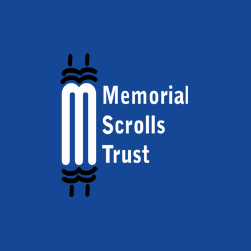
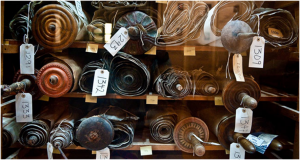
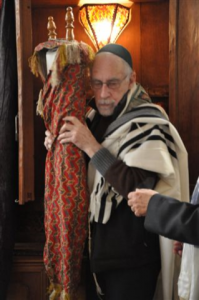
Rimonim (Hebrew for pomegranates) are decorative finials for the Sepher Torah, the five books of Moses written by hand on a long roll of parchment. The Torah is rolled up around two ornate wooden shafts that are attached to either end of the scroll. The rimonim are placed on each of those shafts when the Torah is taken out of the Ehal (Torah Shrine) during festivals. During the restoration works, a pair of discarded rimonim was found in the southern courtyard during excavations. The rimonim comprise a copper base and a heavily carved wooden top in a foliate design, covered with viridian green tempera paint and gold-leaf. Only one of the pair was discovered largely intact. Exact duplicates of these rimonim were made by a local craftsman, complete with viridian green and gold-leaf decoration and bells. They are now used during services and at other times placed on metal supports on both sides of the Torah Shrine, together with another pair of silver rimonim for the second Sepher Torah.
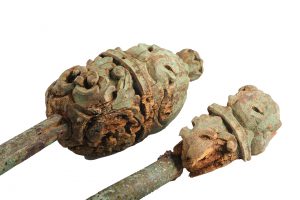
A menorah is a seven-branched lampstand that was used in the Temple in Jerusalem. Fresh olive oil of the purest quality was burned daily to light its lamps. In synagogues today, the Ner Tamid (eternal light) is a symbolic reminder of that Temple’s menorah. The menorah has been a symbol of Judaism since ancient times. As in many other synagogues, a menorah is displayed in Etz Hayyim Synagogue at the base of the Ehal in the sanctuary.
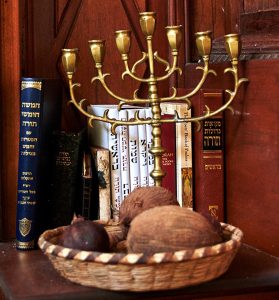
Etz Hayyim was gifted a velvet, gold embroidery talleth (prayer shawl) bag from Ioannina by Mrs Aliki Beraha of Athens. The shawl dates to the late 19th century and was the traditional gift that a bride gave to her husband on the morning of their marriage.
Etz Hayyim received a set of 95 patchwork and embroidered Indian cushions for the benches in the sanctuary that were a gift of Matilda Beraha and Minos Moisis of Athens.
